

Home - KAHS Subject Guides - LibGuides at Kutztown Area High School. Education Technology News and Resources. PadWheel Poster V4. KoehlerMishra. Digital Pedagogy - Best Practices - Digital Pedagogy - A Guide for Librarians, Faculty, and Students - Research guides at University of Toronto. Digital Pedagogy: Is there too much Technology in the Classroom?
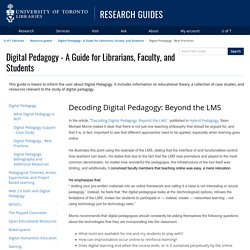
Inquiry-Based Learning. M1 Slide 22 DOK Hess Cognitive Rigor. Webbs DOK Flip Chart. DOKWheel. Feature Article - Inquiry Learning, Summer 2009- Teaching with Primary Sources. Why is inquiry important for student learning?

Inquiry is a process of active learning that is driven by questioning and critical thinking. The understandings that students develop through inquiry are deeper and longer lasting than any pre-packaged knowledge delivered by teachers to students. Inquiry-based learning follows a process that progresses through phases, but is recursive and reflective throughout. The six phases and their thought processes are detailed in the following diagram.
Stripling Model of Inquiry pdf version of Stripling Model of Inquiry (247 KB) Why should primary sources be used for inquiry? By their very nature, primary sources engage students in inquiry. Second, primary sources engage students both emotionally and personally because the sources represent authentic voices and images. Finally, the conflicting nature of primary sources helps students see the complexity of issues and recognize the importance of context for credible interpretation. Mike Eisenberg Vodcast #1—What is Information Literacy? International Journal of Computer-Supported Collaborative Learning - Springer. Connectivism – Foundations of Learning and Instructional Design Technology. A Learning Theory for the Digital Age George Siemens Editor’s Note: This landmark paper, originally published on Siemens’s personal website in 2004 before being published in the International Journal of Instructional Technology and Distance Learning, has been cited thousands of times and is considered a landmark theory for the Internet age.
"When knowledge is abundant, the rapid evaluation of knowledge is important. Additional concerns arise from the rapid increase in information. In today’s environment, action is often needed without personal learning—that is, we need to act by drawing information outside of our primary knowledge. The ability to synthesize and recognize connections and patterns is a valuable skill." – lilaclibrarian
Siemens has since added a website to explore this concept.
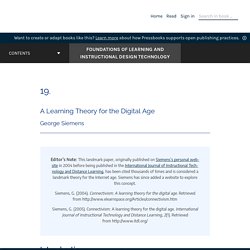
Siemens, G. (2004). Connectivism: A learning theory for the digital age. Siemens, G. (2005). Bloom's Digital Taxonomy Verbs For 21st Century Students - Graphic: Bloom’s Digital Taxonomy Verbs by TeachThought Staff Bloom’s Taxonomy makes the education world go ’round.
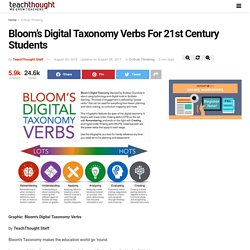
In one model is a framework that not only lays out for teachers the kinds of thinking that we, as humans, tend towards, but also provides a kind of hierarchy that etches out the possible progression of that thinking. If we can remember, we can begin to understand. A Copyright-Friendly Toolkit. However fabulous Creative Commons and Public Domain content may be, sometimes you really need to use copyrighted material. Say you plan to comment on popular media or current events. For instance, you may be planning to critique the portrayal of Native Americans in commercial films. You are going to want to “quote” some commercial films like Pocahontas, Lone Ranger, and Dances with Wolves. If you are reviewing a book, you may want to share its cover art. You may use copyrighted content without asking permission if you believe that your use falls under the doctrine known as Fair Use. In general, when you transform original content, repurpose it, and add value to it in your own remix, you may be able to claim the use fair.
According to American University’s Center for Media and Social Impact, these two tests or questions help you plan whether to use the copyrighted work of others without asking permission: The video below explains why the Code for Fair Use in Online Video was created. Digital portfolios. After a conference, there is the thought that many need something they can do right away with students.
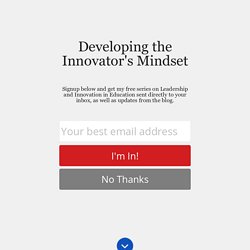
The demands of being a teacher, while also keep opportunities “fresh”, is something that lends to this way of thinking. If you go to any conference, there will be a ton of “apps” shared of cool things you can do, but often times, the learning with this is more novelty than depth. Learning that empowers and makes an impact takes thoughtful leadership at all levels, as well as vision. It also sometimes not only takes a “village”, but the vision of the village to come together. With that being said, I have been focusing on some initiatives that are new(ish) in some schools, that will need communities to come together. Here are three initiatives that will take time, effort, and community to make happen at the systemic level. 1. Teach Students to Think Through Problems — Not Google Them. Aswath Damodaran holds the Kerschner Family Chair in Finance Education and is Professor of Finance at New York University Stern School of Business.
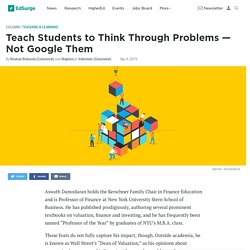
He has published prodigiously, authoring several prominent textbooks on valuation, finance and investing, and he has frequently been named “Professor of the Year” by graduates of NYU’s M.B.A. class. Those feats do not fully capture his impact, though. Outside academia, he is known as Wall Street’s “Dean of Valuation,” as his opinions about companies have a way of influencing the way the world sees them. Additionally, his insistence that videos of his teaching remain freely available allows him to serve students all over the world, at a scale rarely conceived or accomplished by most classroom teachers. We reached out to him to learn about how he deploys his considerable talents. Position Statements. Skip to main content Position Statements The following position statement is currently under review to align with the National School Library Standards:
